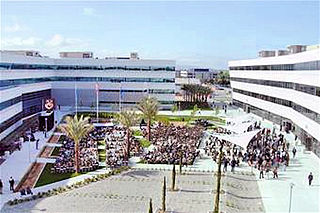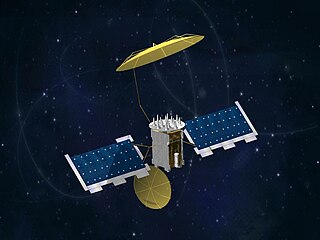Related Research Articles

The Defense Advanced Research Projects Agency (DARPA) is a research and development agency of the United States Department of Defense responsible for the development of emerging technologies for use by the military.

The Defense Information Systems Agency (DISA), known as the Defense Communications Agency (DCA) until 1991, is a United States Department of Defense (DoD) combat support agency composed of military, federal civilians, and contractors. DISA provides information technology (IT) and communications support to the President, Vice President, Secretary of Defense, the military services, the combatant commands, and any individual or system contributing to the defense of the United States.
Lockheed Martin Corporation is an American aerospace, defense, arms, security, and advanced technologies company with worldwide interests. It was formed by the merger of Lockheed Corporation with Martin Marietta in March 1995. It is headquartered in North Bethesda, Maryland, in the Washington, D.C., area. Lockheed Martin employs approximately 110,000 people worldwide as of January 2020.

The Air Force Research Laboratory (AFRL) is a scientific research organization operated by the United States Air Force Materiel Command dedicated to leading the discovery, development, and integration of aerospace warfighting technologies, planning and executing the Air Force science and technology program, and providing warfighting capabilities to United States air, space, and cyberspace forces. It controls the entire Air Force science and technology research budget which was $2.4 billion in 2006.

The Joint Tactical Radio System (JTRS) aimed to replace existing radios in the American military with a single set of software-defined radios that could have new frequencies and modes (“waveforms”) added via upload, instead of requiring multiple radio types in ground vehicles, and using circuit board swaps in order to upgrade. JTRS has seen cost overruns and full program restructurings, along with cancellation of some parts of the program. JTRS is widely seen as one of the DoD's greatest acquisition failures, having spent $6B over 15 years without delivering a radio.

Los Angeles Air Force Base (LAAFB) is a United States Air Force Base located in El Segundo, California. Los Angeles Air Force Base houses and supports the headquarters of the United States Space Force's Space and Missile Systems Center (SMC). The center manages research, development and acquisition of military space systems. The 61st Air Base Group provides support functions for the base.

The Mobile User Objective System is a narrowband military communications satellite system that supports a worldwide, multi-Service population of users in the ultra high frequency (UHF) band. The system provides increased communications capabilities to newer, smaller terminals while still supporting interoperability with legacy terminals. MUOS is designed to support users who require greater mobility, higher bit rates and improved operational availability. The MUOS was declared fully operational for use in 2019
The Aerospace Corporation is an American California nonprofit corporation that operates a federally funded research and development center (FFRDC) headquartered in El Segundo, California. The corporation provides technical guidance and advice on all aspects of space missions to military, civil, and commercial customers. As the FFRDC for national-security space, Aerospace works closely with organizations such as the United States Air Force Space and Missile Systems Center (SMC) and the National Reconnaissance Office (NRO) to provide "objective technical analyses and assessments for space programs that serve the national interest". Although SMC and NRO are the primary customers, Aerospace also performs work for civil agencies as well as international organizations and governments in the national interest.
The Defense Information System Network (DISN) has been the United States Department of Defense's enterprise telecommunications network for providing data, video and voice services for 40 years.

The United States Under Secretary of Defense for Policy (USDP) is a high level civilian official in the United States Department of Defense. The Under Secretary of Defense for Policy is the principal staff assistant and adviser to both the Secretary of Defense and the Deputy Secretary of Defense for all matters concerning the formation of national security and defense policy.

The Under Secretary of Defense for Intelligence or USD(I) is a high-ranking civilian position in the Office of the Secretary of Defense (OSD) within the U.S. Department of Defense that acts as the principal civilian advisor and deputy to the United States Secretary of Defense and Deputy Secretary of Defense on matters relating to military intelligence. The Under Secretary is appointed from civilian life by the President and confirmed by the Senate to serve at the pleasure of the President.

Viasat Inc. is an American communications company based in Carlsbad, California, with additional operations across the United States and worldwide. Viasat is a provider of high-speed satellite broadband services and secure networking systems covering military and commercial markets.

The Wideband Global SATCOM system (WGS) is a high capacity United States Space Force satellite communications system planned for use in partnership by the United States Department of Defense (DoD), Canadian Department of National Defence (DND) and the Australian Department of Defence. The system is composed of the Space Segment satellites, the Terminal Segment users and the Control Segment operators.
LandWarNet (LWN) is the United States Army’s contribution to the Global Information Grid (GIG) that consists of all globally interconnected, end-to-end set of Army information capabilities, associated processes, and personnel for collecting, processing, storing, disseminating, and managing information on demand supporting warfighters, policy makers, and support personnel. It includes all Army and leveraged Department of Defense (DOD)/Joint communications and computing systems and services, software, data security services, and other associated services. LandWarNet exists to enable the warfighter through Mission Command, previously described as Battle Command. Other U.S. service equivalent efforts to LandWarNet include the Navy's "FORCEnet" and the Air Force's "C2 Constellation."

Advanced Extremely High Frequency (AEHF) is a series of communications satellites operated by the United States Space Force. They will be used to relay secure communications for the Armed Forces of the United States, the British Armed Forces, the Canadian Armed Forces, the Royal Netherlands Armed Forces and the Australian Defence Force. The system will consist of six satellites in geostationary orbits. The final satellite was launched on 26 March 2020. AEHF is backward compatible with, and will replace, the older Milstar system and will operate at 44 GHz Uplink and 20 GHz Downlink. The AEHF system is a joint service communications system that will provide survivable, global, secure, protected, and jam-resistant communications for high-priority military ground, sea and air assets.

The Military Satellite Communications Directorate is a United States Space Force organization headquartered at Los Angeles Air Force Base, California. It is one of several wings and other units that make up the Space and Missile Systems Center (SMC).

Elizabeth Ann Hight is a retired United States Navy rear admiral who served as the vice director of the Defense Information Systems Agency (DISA). She assumed this post in December 2007. In 2008, she was nominated for appointment to the grade of vice admiral and assignment as director, Defense Information Systems Agency; commander, Joint Task Force – Global Network Operations; and deputy commander, U.S. Strategic Command Global Network Operations and Defense, Arlington, Virginia. Her nomination was rejected by the Senate due to a perceived conflict of interest with her husband, retired Air Force Brigadier General Gary Salisbury, who is vice president of business development and sales for Northrop Grumman Corp.'s mission systems sector, defense mission systems division. She retired from the Navy in 2010.
General Dynamics Mission Systems is a business unit of American defense and aerospace company General Dynamics. General Dynamics Mission Systems integrates secure communication and information systems and technology. General Dynamics Mission Systems has core manufacturing in secure communications networks; radios and satellite technology for the defense, cyber, public safety, and intelligence communities.

PM WIN-T is a component of Program Executive Office Command, Control and Communications-Tactical in the United States Army. PM WIN-T has been absorbed into PM Tactical Networks as Product Manager for Mission Networks.
The AeroVironment Global Observer is a concept for a high-altitude, long endurance unmanned aerial vehicle, designed by AeroVironment (AV) to operate as a stratospheric geosynchronous satellite system with regional coverage.
References
Notes
- ↑ Levin, Robert E. (2003-12-04). "Space Acquisitions: Committing Prematurely to the Transformational Satellite Program Elevates Risks for Poor Cost, Schedule, and Performance Outcomes" (PDF). U.S. Government Accountability Office. Retrieved 2011-01-01.
- ↑ "IRconnect". Archived from the original on 2011-07-13. Retrieved 2011-03-14.
- ↑ Pasztor, Andy, "Pentagon Delays Program To Build New Satellite System", Wall Street Journal , October 21, 2008, p. 7.
- ↑ Washington Post, "Satellite Competition Renewed", December 31, 2008, p. D3.
- ↑ "Defense Budget Recommendation Statement (Arlington, VA) as Prepared for Delivery by Secretary of Defense Robert M. Gates, Arlington, VA, Monday, April 06, 2009".